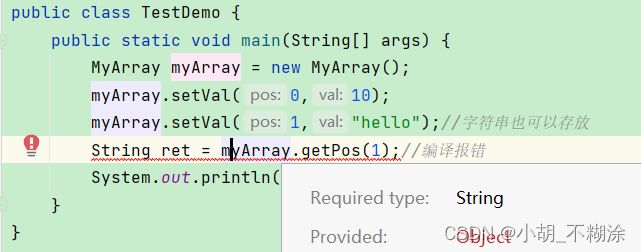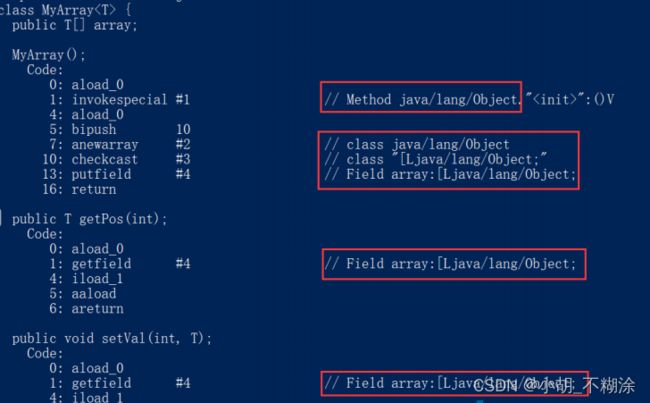【数据结构】泛型
⭐ 作者:小胡_不糊涂
作者主页:小胡_不糊涂的个人主页
收录专栏:浅谈Java
持续更文,关注博主少走弯路,谢谢大家支持
泛型
- 1. 包装类
-
- 1.1 基本数据类型和对应的包装类
- 1.2 装箱和拆箱
- 1.3 自动装箱和拆箱
- 2. 什么是泛型
-
- 2.1 语法
- 3. 泛型类的使用
- 4. 泛型如何编译
-
- 4.1 擦除机制
- 4.2 为什么不能实例化泛型类型数组
- 5. 泛型的上界
- 6. 泛型方法
1. 包装类
在Java中,由于基本类型不是继承自Object,为了在泛型代码中可以支持基本类型,Java给每个基本类型都对应了
一个包装类型。
1.1 基本数据类型和对应的包装类
| 基本数据类型 | 包装类 |
|---|---|
| byte | Byte |
| short | Short |
| int | Integer |
| long | Long |
| float | Float |
| double | Double |
| char | Character |
| boolean | Boolean |
除了 Integer 和 Character,其余基本类型的包装类都是首字母大写。
1.2 装箱和拆箱
int i = 10;
// 装箱操作,新建一个 Integer 类型对象,将 i 的值放入对象的某个属性中
Integer ii = Integer.valueOf(i);
Integer ij = new Integer(i);
// 拆箱操作,将 Integer 对象中的值取出,放到一个基本数据类型中
int j = ii.intValue();
1.3 自动装箱和拆箱
可以看到在使用过程中,装箱和拆箱带来不少的代码量,所以为了减少开发者的负担,java 提供了自动机制。
int i = 10;
Integer ii = i; // 自动装箱
Integer ij = (Integer)i; // 自动装箱
int j = ii; // 自动拆箱
int k = (int)ii; // 自动拆箱
有奖竞答:下列代码输出什么,为什么?
public static void main(String[] args) {
Integer a = 127;
Integer b = 127;
Integer c = 128;
Integer d = 128;
System.out.println(a == b);
System.out.println(c == d);
}
先看一下 Integer 的源码,可以知道被 Integer 修饰的变量取值范围是 -128~127。

所以,答案应该是:
2. 什么是泛型
泛型: 就是适用于许多许多类型。从代码上讲,就是对类型实现了参数化。
首先解决这样一个问题:
实现一个类,类中包含一个数组成员,使得数组中可以存放任何类型的数据,也可以根据成员方法返回数组中某个下标的值?
按照我们之前的想法是使用数组,但数组只能存放指定类型的元素,例如:int[] array = new int[10]; String[] strs = newString[10];
而且所有类的父类,默认为Object类。数组是否可以创建为Object?
class MyArray {
public Object[] array = new Object[10];
public Object getPos(int pos) {
return this.array[pos];
}
public void setVal(int pos,Object val) {
this.array[pos] = val;
}
}
public class TestDemo {
public static void main(String[] args) {
MyArray myArray = new MyArray();
myArray.setVal(0,10);
myArray.setVal(1,"hello");//字符串也可以存放
String ret = myArray.getPos(1);//编译报错
System.out.println(ret);
}
}

上述代码中,虽然在 myArray 中任何类型的数据都可以存放,而且1号下标的元素是String类型的,但仍编译报错,此处必须进行强制类型转换。
虽然在这种情况下,当前数组任何数据都可以存放,但是,更多情况下,我们还是希望他只能够持有一种数据类型。而不是同时持有这么多类型。
所以,泛型的主要目的:就是指定当前的容器,要持有什么类型的对象。让编译器去做检查。此时,就需要把类型,作为参数传递。需要什么类型,就传入什么类型。
2.1 语法
class 泛型类名称<类型形参列表> {
// 这里可以使用类型参数
}
class ClassName<T1, T2, ..., Tn> {
}
class 泛型类名称<类型形参列表> extends 继承类/* 这里可以使用类型参数 */ {
// 这里可以使用类型参数
}
class ClassName<T1, T2, ..., Tn> extends ParentClass<T1> {
// 可以只使用部分类型参数
}
将上述代码进行改写如下:
class MyArray<T> {
public T[] array = (T[])new Object[10];//注释1
public T getPos(int pos) {
return this.array[pos];
}
public void setVal(int pos,T val) {
this.array[pos] = val;
}
}
public class TestDemo {
public static void main(String[] args) {
MyArray<Integer> myArray = new MyArray<>();//注释2
myArray.setVal(0,10);
myArray.setVal(1,12);
int ret = myArray.getPos(1);//注释3
System.out.println(ret);
myArray.setVal(2,"hello");//注释4
}
}
代码解释:
- 类名后的 代表占位符,表示当前类是一个泛型类。
类型形参一般使用一个大写字母表示,常用的名称有:
E 表示 Element
K 表示 Key
V 表示 Value
N 表示 Number
T 表示 Type
S, U, V 等等 - 第二、第三、第四个类型
- 上面代码注释1处,不能new泛型类型的数组。
比如下面的语句就是不对的:
T[] ts = new T[5];//error
- 注释2处,类型后加入
- 注释3处,不需要进行强制类型转换。
- 注释4处,代码编译报错,此时因为在注释2处指定类当前的类型,此时在注释4处,编译器会在存放元素的时候帮助我们进行类型检查。
3. 泛型类的使用
语法:
泛型类<类型实参> 变量名; // 定义一个泛型类引用
new 泛型类<类型实参>(构造方法实参); // 实例化一个泛型类对象
示例:
MyArray<Integer> list = new MyArray<Integer>();
MyArray<Integer> list = new MyArray<>(); // 可以推导出实例化需要的类型实参为Integer
泛型只能接受类,所有的基本数据类型必须使用包装类!
4. 泛型如何编译
4.1 擦除机制
通过cmd窗口的命令:javap -c 查看字节码文件,可见所有的T都是Object。

在编译的过程当中,将所有的T替换为Object这种机制,我们称为:擦除机制。
Java的泛型机制是在编译级别实现的。编译器生成的字节码在运行期间并不包含泛型的类型信息。
4.2 为什么不能实例化泛型类型数组
先看一段代码:
class MyArray<T> {
public T[] array = (T[])new Object[10];
public T getPos(int pos) {
return this.array[pos];
}
public void setVal(int pos,T val) {
this.array[pos] = val;
}
public T[] getArray() {
return array;
}
}
public static void main(String[] args) {
MyArray<Integer> myArray1 = new MyArray<>();
Integer[] strings = myArray1.getArray();
}
/*
Exception in thread "main" java.lang.ClassCastException: [Ljava.lang.Object; cannot be cast to [Ljava.lang.Integer;
at TestDemo.main(TestDemo.java:31)
*/
报错原因:替换后的方法为:将Object[]分配给Integer[]引用,程序报错。
在getArray()返回的Object数组里面,可能存放的是任何的数据类型,可能是String,可能是Person,运行的时候,直接转给Integer类型的数组,编译器认为是不安全的
将上述代码修改为:
class MyArray<T> {
public T[] array;
public MyArray() {
}
/**
* 通过反射创建,指定类型的数组
* @param clazz
* @param capacity
*/
public MyArray(Class<T> clazz, int capacity) {
array = (T[])Array.newInstance(clazz, capacity);
}
public T getPos(int pos) {
return this.array[pos];
}
public void setVal(int pos,T val) {
this.array[pos] = val;
}
public T[] getArray() {
return array;
}
}
public static void main(String[] args) {
MyArray<Integer> myArray1 = new MyArray<>(Integer.class,10);
Integer[] integers = myArray1.getArray();
}
5. 泛型的上界
在定义泛型类时,有时需要对传入的类型变量做一定的约束,可以通过类型边界来约束。
语法:
class 泛型类名称<类型形参 extends 类型边界> {
...
}
示例:
public class MyArray<E extends Number> {
...
}
只接受 Number 的子类型作为 E 的类型实参
MyArray<Integer> l1; // 正常,因为 Integer 是 Number 的子类型
MyArray<String> l2; // 编译错误,因为 String 不是 Number 的子类型
没有指定类型边界 E,可以视为 E extends Object
复杂示例:
public class MyArray<E extends Comparable<E>> {
...
}
E必须是实现了Comparable接口的
6. 泛型方法
语法:
方法限定符 <类型形参列表> 返回值类型 方法名称(形参列表) { ... }
示例1:
public class Util {
//静态的泛型方法 需要在static后用<>声明泛型类型参数
public static <E> void swap(E[] array, int i, int j) {
E t = array[i];
array[i] = array[j];
array[j] = t;
}
}
示例2:可以类型推导
Integer[] a = { ... };
swap(a, 0, 9);
String[] b = { ... };
swap(b, 0, 9);
示例3:不使用类型推导
Integer[] a = { ... };
Util.<Integer>swap(a, 0, 9);
String[] b = { ... };
Util.<String>swap(b, 0, 9);
